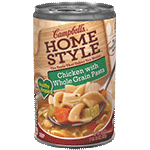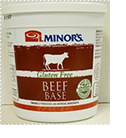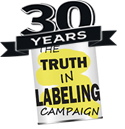LABEL LIES
Basic Facts (things the "glutes" don't want you to know)
This is How the "MSG is Safe" Game is Played
Propaganda
 Here's how they hide MSG
Here's how they hide MSG
1) With “Clean Labels”
“Clean labels” are labels of products that contain MSG (which is made of excitotoxic -- brain damaging -- free glutamate), with names that don't give the consumer a clue to its presence.
Example: Campbell's Home Style Healthy Request Chicken with Whole Grain Pasta Soup.

Ingredients:
Chicken Stock, Carrots, Chicken Meat, Pasta (Whole Wheat Flour, Wheat Flour, Egg Whites), Celery, Contains Less Than 2% Of: Water, Potassium Chloride, Salt, Chicken Fat, Yeast Extract, Carrot Juice Concentrate, Sugar, Flavoring, Xanthan Gum, Carrageenan, Potato Starch, Chicken Broth*, Spices, Cabbage, Onions, Onions*, Locust Bean Gum, Parsley, Celery Extract, Lactic Acid, Turmeric Extract, Onion Extract, Garlic Extract. * Dried
(From Campbell's Soups, accessed 1/1/2019)
2) With claims of “No MSG” or “No MSG added” when the product contains excitotoxic free glutamate.
Example: Minor's Beef Base
 Ingredients: roasted beef and beef stock, salt, sugar, natural flavors, tomato paste, 2% or less of water, potato starch, yeast extract, sunflower oil, corn oil, beef fat, lactic acid.
Ingredients: roasted beef and beef stock, salt, sugar, natural flavors, tomato paste, 2% or less of water, potato starch, yeast extract, sunflower oil, corn oil, beef fat, lactic acid.
No added MSG - Other than that which naturally occurs in the yeast extract. (Emphasis added).
Minor's soup bases are sold to restaurants that, in good faith, may believe that those bases that claim to be MSG free are truly MSG free (free of free glutamate).
(From Soupbase.com, accessed 1/1/2019)
Example: RC Low Sodium Instant Turkey Gravy Mix
 Ingredients: Wheat flour, turkey fat (with natural flavor), roasted turkey gizzards, cooked turkey meat, salt, sugar, modified tapioca starch, guar gum, chicken flavor, turkey flavor, hydrolyzed corn protein, onion powder, hydrolyzed wheat protein, sunflower oil, whey (from milk), caramel color, potato flour, disodium inosinate, disodium guanylate, dextrose, maltodextrin, autolyzed yeast extract, natural flavor, spices, yeast extract, and garlic powder. (Emphasis added)
Ingredients: Wheat flour, turkey fat (with natural flavor), roasted turkey gizzards, cooked turkey meat, salt, sugar, modified tapioca starch, guar gum, chicken flavor, turkey flavor, hydrolyzed corn protein, onion powder, hydrolyzed wheat protein, sunflower oil, whey (from milk), caramel color, potato flour, disodium inosinate, disodium guanylate, dextrose, maltodextrin, autolyzed yeast extract, natural flavor, spices, yeast extract, and garlic powder. (Emphasis added)
(From RC Fine Foods website, accessed 1/1/2019).
3) With confusion through use of misleading -- or just plain false -- statements such as:
“MSG occurs naturally in ingredients such as hydrolyzed vegetable protein, autolyzed yeast, hydrolyzed yeast, yeast extract, soy extracts, and protein isolate, as well as in tomatoes and cheeses.” (From the FDA, Questions and answers on Monosodium Glutamate accessed 1/1/2019)."According to Campbell’s: MSG, or Monosodium Glutamate, is an ingredient that adds savory taste to foods. Its been used safely for more than a century. MSG is a common flavor enhancer added by chefs and food manufacturers alike. Glutamate, a component of MSG, occurs naturally in some vegetables and processed ingredients, such as hydrolyzed vegetable protein and yeast extract. Foods containing MSG will note it clearly in the ingredient statement on our product labels.” (From D-Mom Blog accessed 1/1/2019).
“Monosodium glutamate (MSG) is the sodium salt of a common amino acid. MSG occurs naturally in many foods, such as tomatoes and cheeses. It has been used safely as a seasoning in cooking for more than 100 years." (From Campbell's FAQ) accessed 1/7/2019.
4) Using “MSG” as an abbreviation for "monosodium glutamate" without defining it. The acronym "MSG" is promoted by industry as standing for "monosodium glutamate" while it is well known that for many people, “MSG” stands for any product that contains processed free glutamic acid.

